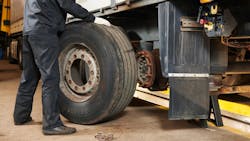The assumed simplicity of tire service and basic vehicle maintenance continues to result in an alarming number of fatalities for fleets. Someone with mechanical aptitude looks at the problem and figures it’s just a few nuts and bolts. They’ve seen the guys who do that work, so it can’t be that difficult. One minute they’re fixing the brakes on the truck and a minute later, they’re crushed under the vehicle because it slipped off the jack. I’ve studied fatality data from the Occupational Safety and Health Administration (OSHA) for the 10-year period of 2010-2019, and the same stories have tragic endings that repeat themselves year after year.
For example, in August 2017, some employees at a pallet company decided to repair a tire on a small loader. They put sealant in the tire and then used ether to seat the beads by igniting it with a propane torch. During inflation, the assembly exploded, and a rim component lacerated the neck of a worker, which resulted in a fatality.
Just a few months later in November of that same year, a welding company 1,000 miles away was using a torch to cut the axle on a loader truck with a fully inflated tire on the end. According to OSHA, “the pressurized tire got into a fire, which caused the tire to blow out. The worker was struck and killed by a projectile of the outer lip of the rim on the upper body, which tore his body vertically in half and was found 150 feet away from the location of the incident.” Vertically in half, 150 feet away.
The OSHA data showed that the leading cause of death in the field of vehicle maintenance and repair continues to be the vehicle slipping off the jack and crushing the worker. Rollover accidents happen when a technician is still working under the vehicle, and the driver puts the truck in gear and literally drives over the technician. Rollovers and tire separations during inflation are a close second and third in the “how you’re going to die” category of vehicle maintenance, repair, and service. There are a few other isolated incidents outside those areas, but the majority are lifting, rollovers, and separations.
Preventing a lifting accident is as simple as using jack stands that are rated for the load; however, the overwhelming majority of lifting fatalities never mention a jack stand. The most likely causes are a truck slipping off the jack or the jack failing. It’s also important to note that a number of the lifting accidents occurred in fleets. Like the pallet and welding companies in 2017, someone determined that the job did not require an outside specialist, so the employees proceeded to do it in-house.
Almost half of the fatalities in vehicle maintenance from 2015 to 2019 were related to lifting a vehicle, and about half of the total fatalities in the same time period were associated with fleets. It’s dangerous enough to try and “do it yourself” when attempting to repair a truck or large machine if it needs to be lifted off the ground, and you are required to work under it. It’s careless and reckless to try it without a jack stand.
Lockout/tagout and tire inflation restraining devices will solve most of the remaining problems. There must be some form of communication with the driver that the vehicle is being serviced and cannot be moved. The same type of accidents keep happening where the drivers take off while the technicians are still under the trucks or trailers. I have firsthand knowledge of how easily it can happen. We have to educate drivers to check under the vehicle before driving away after any type of service.
Education is also needed for the do-it-yourself fleets. Most of the tire separations that occurred during inflation did not involve a restraining device or safety cage. Regardless of the cause, the assembly or components of the assembly become projectiles and cause fatal injuries when the air is suddenly released, and the technician is standing in the trajectory of the sidewall. Fleets that service their own tires and wheels must have OSHA-compliant inflation devices and restraining devices (safety cage) to contain the assemblies during inflation.
The pressure on fleet managers to cut costs has never been greater. Saving a few dollars in the short term may seem like a good business practice, but not if it comes at the expense of employee safety. Properly trained workers with the required safety equipment know the hazards as well as the steps they have to take to protect themselves from those hazards. Simple practices like using jack stands, lockout/tagout devices, and OSHA-compliant inflation devices when servicing vehicles would prevent a lot of accidents.
Trained professionals understand the risks. They know what they must do to protect themselves from potentially fatal situations. The do-it-yourselfers are just guessing and hoping that nothing goes wrong. That being said, working under vehicles supported by jack stands, utilizing lockout/tagout devices, and following OSHA regulations when inflating tires will improve the odds of nothing going wrong.
About the Author
Kevin Rohlwing
Kevin Rohlwing is the SVP of training for the Tire Industry Association. He has more than 40 years of experience in the tire industry and has created programs to help train more than 180,000 technicians.
